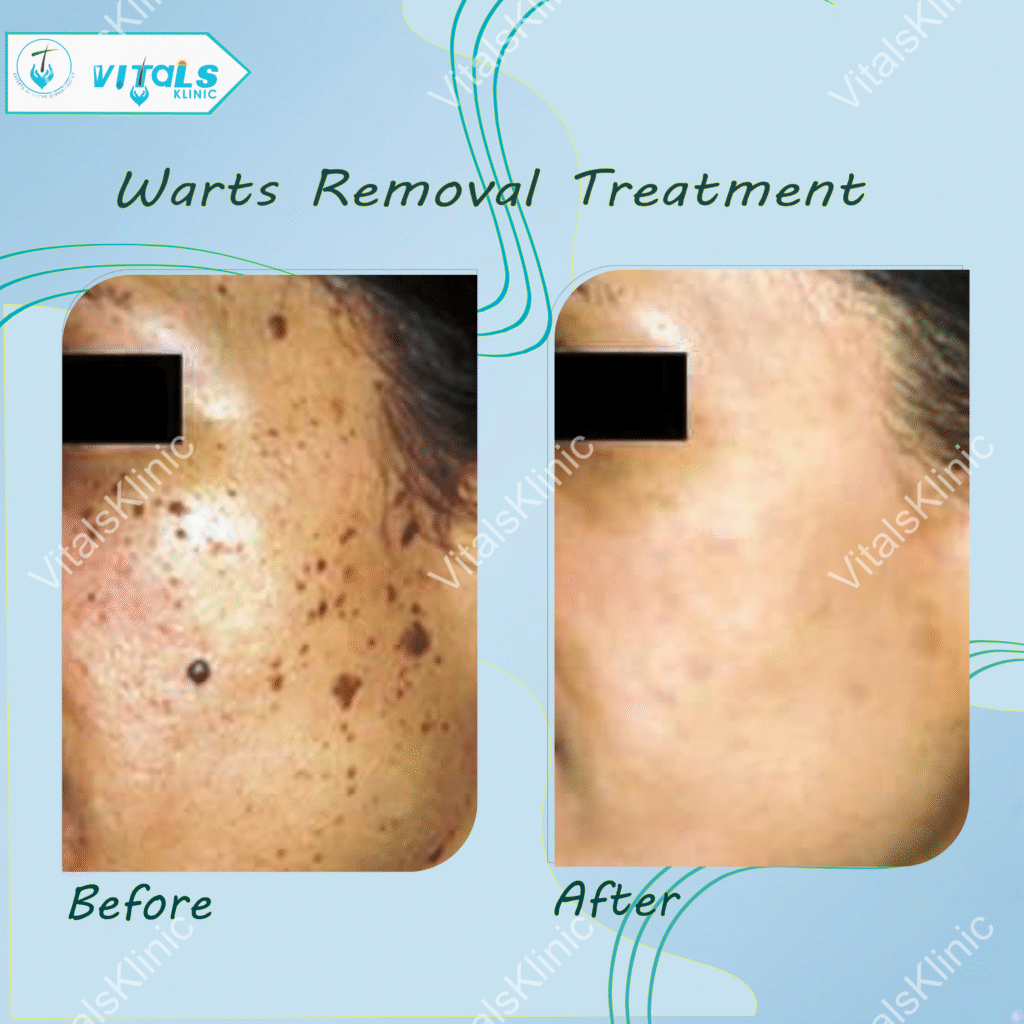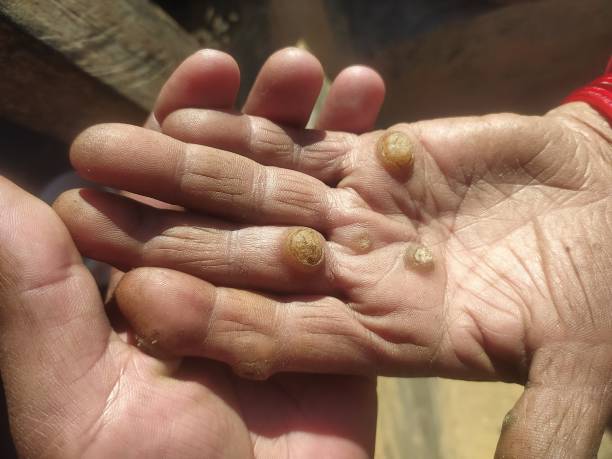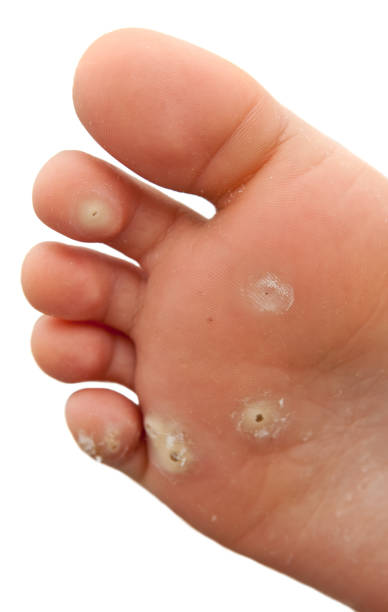Wart Removal Treatment In Bangalore-2025

Understanding Warts – Causes, Types, and Symptoms
Warts are small, non-cancerous skin growths caused by certain strains of the human papillomavirus (HPV). They can develop on various body parts, including the hands, feet, face, and genitals. While warts are generally harmless, they are contagious, can cause discomfort, and may spread if left untreated.
Causes of Warts:
-
Direct skin-to-skin contact with someone who has warts
-
Touching contaminated surfaces
-
Tiny cuts or abrasions that allow the virus to enter the skin
-
Low immunity levels making the body more susceptible to HPV
Symptoms of Warts:
-
Rough, raised, or flat skin growths
-
Small black dots (clotted blood vessels)
-
Pain or tenderness, especially in weight-bearing areas like the soles of feet
Wart removal treatment in Bangalore focuses not only on removing visible growths but also on reducing the chance of recurrence by targeting the root cause.
Why Choose Wart Removal Treatment in Bangalore?
Bangalore is a medical hub equipped with state-of-the-art dermatology clinics and specialized skin care facilities. Choosing to get wart removal here ensures:
-
Access to modern technology like advanced laser systems and cryotherapy units
-
Experienced dermatologists who treat hundreds of wart cases annually
-
Minimal discomfort and quick recovery times
-
Customized aftercare to prevent reappearance
Clinics such as Vitalsklinic follow strict hygiene protocols, use FDA-approved equipment, and adopt tailored treatment plans that match each patient’s unique needs.
Types of Warts and Their Treatments
Common Warts
Appear as rough, raised bumps, often on fingers, knuckles, and knees.
Treatment options: Cryotherapy, salicylic acid application, laser therapy.
Plantar Warts
Develop on the soles of the feet, causing pain when walking.
Treatment options: Laser ablation, cryotherapy, or minor surgical removal.
Flat Warts
Smooth, flat-topped, and skin-colored, usually appearing in clusters on the face, neck, or legs.
Treatment options: Chemical peels, laser treatment, or prescription creams.
Filiform Warts
Long, thin projections often found on the face, eyelids, or neck.
Treatment options: Electrocautery, laser removal, or excision.
Advanced Wart Removal Methods – Detailed Explanation
1. Laser Wart Removal
Laser wart removal is one of the most precise and effective modern techniques.
-
How it works: A focused beam of high-intensity light targets the wart’s blood vessels and tissue. The heat from the laser destroys the infected cells while leaving surrounding skin unharmed.
-
Benefits: Minimal bleeding, reduced pain, faster healing time (usually within 5–7 days), and lower recurrence rates compared to traditional methods.
-
Best for: Facial warts, stubborn warts that resist other treatments, and patients seeking minimal scarring.
-
Aftercare: Mild redness is common; apply soothing ointment and avoid sun exposure until healed.
2. Cryotherapy
Cryotherapy is a popular and widely used wart removal treatment in Bangalore.
-
How it works: Liquid nitrogen at -196°C is applied to the wart, instantly freezing it. This causes the wart tissue to blister and separate from healthy skin. Within a few days, the dead tissue falls off naturally.
-
Benefits: Quick in-clinic procedure (5–10 minutes), minimal discomfort, and suitable for most wart types.
-
Limitations: May require 2–4 sessions depending on wart size and depth. Can cause temporary skin discoloration in some cases.
-
Best for: Common warts, plantar warts, and flat warts.
-
Aftercare: Keep the area clean, avoid popping blisters, and follow the doctor’s cleaning instructions.
3. Electrocautery
Electrocautery uses controlled heat from an electric current to burn and remove wart tissue.
-
How it works: A fine needle-like probe delivers electricity directly to the wart, effectively destroying the infected tissue and sealing blood vessels at the same time.
-
Benefits: Immediate removal in a single session for many cases, minimal bleeding, and reduced infection risk because the heat sterilizes the area.
-
Limitations: May leave a small mark that fades over time; requires local anesthesia.
-
Best for: Large, thick, or stubborn warts that haven’t responded to other treatments.
-
Aftercare: Keep the treated area covered for 1–2 days and avoid water contact until healing begins.
4. Surgical Excision
Surgical excision is a minor outpatient procedure for completely removing the wart.
-
-
How it works: The dermatologist uses a sterile surgical blade or scissors to cut out the wart along with a small margin of healthy tissue to ensure complete removal.
-
Benefits: Immediate elimination of the wart, suitable for very large or deep-rooted growths.
-
Limitations: Slightly longer recovery period compared to other methods and a small risk of scarring.
-
Best for: Deep plantar warts, filiform warts, or warts resistant to laser and cryotherapy.
-
Aftercare: Keep the wound clean and covered, apply prescribed ointments, and attend follow-up appointments to monitor healing.
-
Home Remedies vs. Professional Treatment
Home Remedies:
-
Examples: Apple cider vinegar, garlic paste, banana peel
-
Pros: Low cost, accessible
-
Cons: Slow results, higher recurrence, possible skin irritation
Professional Treatment:
-
Precise removal with advanced equipment
-
Faster healing
-
Lower recurrence rate
When compared, professional treatment in Bangalore—especially at Vitalsklinic—offers the best combination of safety, speed, and effectiveness.
Wart Removal Procedure at Vitalsklinic
At Vitalsklinic, wart removal is done through a carefully designed 5-step process:
-
Consultation and Diagnosis – The dermatologist examines the wart’s type, size, depth, and location to select the best removal method.
-
Preparation – The skin is cleaned, and local or topical anesthesia is applied for comfort.
-
Precise Removal – Using FDA-approved laser technology, cryotherapy, or electrocautery, the wart is removed without harming healthy skin.
-
Aftercare Application – A healing ointment is applied to speed up recovery and protect against infection.
-
Follow-Up Check – A review appointment ensures complete healing and monitors for recurrence.
Vitalsklinic prioritizes patient safety, minimal scarring, and long-term results, making it one of the top choices for wart removal in Bangalore.
How to Choose the Right Dermatologist
-
Verify qualifications and certifications
-
Ensure the clinic uses modern, sterile equipment
-
Read authentic patient reviews
-
Ask about the clinic’s success rate for wart removal
Preparing for Your Wart Removal Procedure
-
Avoid using over-the-counter wart treatments before your appointment
-
Share your medical history and allergies with your dermatologist
-
Wear loose clothing if warts are on the body
Recovery and Aftercare Tips
-
Keep the treated area clean and dry
-
Avoid scratching or picking
-
Apply prescribed ointments as directed
-
Protect the area from direct sunlight
-
Attend follow-up visits to ensure complete healing
How to Prevent Warts from Coming Back
-
Maintain good hygiene habits
-
Avoid sharing towels, shoes, or personal items
-
Wear flip-flops in public showers or pools
-
Strengthen your immune system through diet and exercise
Myths and Facts About Wart Removal
-
Myth: Warts have roots like plants.
Fact: They’re caused by a virus, not roots. -
Myth: Only children get warts.
Fact: Anyone can develop warts. -
Myth: Cutting a wart makes it spread.
Fact: Spread happens through viral transmission, not cutting alone.
Possible Side Effects and Risks of Wart Removal
Modern wart removal treatments—such as laser therapy, cryotherapy, electrocautery, and surgical excision—are generally very safe when performed by qualified dermatologists. However, like any medical procedure, they may carry some temporary side effects or, in rare cases, mild risks.
Common Temporary Side Effects
These effects are part of the normal healing process and usually subside within a few days to weeks:
-
Redness and Swelling
-
The treated area may appear slightly red or swollen immediately after the procedure.
-
This is due to increased blood flow during healing and usually settles within 48 hours.
-
-
Mild Discomfort or Tenderness
-
A slight stinging or soreness can occur, especially in areas like the feet where pressure is applied during walking.
-
Over-the-counter pain relief or a cool compress can help ease this discomfort.
-
-
Crusting or Scabbing
-
As the skin heals, a thin crust may form over the treated area.
-
This should not be picked at, as doing so can delay healing or cause marks.
-
-
Temporary Skin Color Changes
-
Some people may notice the skin becoming slightly lighter or darker after treatment.
-
This usually fades naturally over time, especially if sun protection is used.
-
Rare Risks
While uncommon, a few possible risks may occur if aftercare instructions are not followed:
-
Minimal Scarring
-
Most modern methods aim to avoid scars, but very deep warts or surgical excision can occasionally leave a faint mark.
-
Proper wound care and scar-healing creams can minimize this.
-
-
Infection
-
If the treated area is not kept clean and dry, bacteria may enter, causing redness, pus, or pain.
-
This is rare and can be prevented with proper hygiene.
-
-
Recurrence of Warts
-
In some cases, the wart virus may still be present in nearby skin and cause regrowth.
-
Strengthening immunity and avoiding contact with infected surfaces can help prevent recurrence.
-
How Clinics Like Vitalsklinic Reduce Risks
-
-
Using FDA-approved, sterilized equipment
-
Applying precise, targeted treatments to minimize damage to healthy skin
-
Providing personalized aftercare instructions to ensure smooth healing
-
Scheduling follow-ups to monitor progress and prevent recurrence
-
Aftercare Do’s and Don’ts After Wart Removal Treatment
Proper aftercare plays a big role in speeding up healing, reducing discomfort, and preventing recurrence after wart removal. At Vitalsklinic, dermatologists provide tailored aftercare instructions, but here’s a general guide for all patients:
Do’s (Recommended Aftercare)
-
Keep the Area Clean and Dry
-
Gently wash the treated area with mild soap and lukewarm water.
-
Pat dry using a clean, soft towel — avoid rubbing.
-
-
Apply Prescribed Ointments or Creams
-
Use only the medications given by your dermatologist to promote healing and prevent infection.
-
-
Protect the Skin from Sunlight
-
Apply a dermatologist-approved sunscreen (SPF 30 or above) if the treated area is exposed to sunlight.
-
This helps prevent pigmentation changes during healing.
-
-
Wear Comfortable Clothing or Footwear
-
Avoid tight or rough fabrics over the treated area to reduce irritation.
-
If the wart was on the foot, wear cushioned footwear.
-
-
Follow the Recommended Follow-Up Schedule
-
Attend check-up visits so your dermatologist can monitor healing and detect early signs of recurrence.
-
Don’ts (Things to Avoid)
-
Don’t Scratch, Rub, or Pick at the Treated Area
-
This can delay healing, cause scarring, and increase infection risk.
-
-
Avoid Using Over-the-Counter Wart Products
-
Salicylic acid or other harsh chemicals may irritate healing skin.
-
-
Don’t Submerge the Area in Water for Long Periods
-
Avoid swimming pools, hot tubs, or soaking in baths for at least 5–7 days unless advised otherwise.
-
-
Avoid Heavy Exercise or Friction on the Treated Area
-
For example, if your wart was on your foot, avoid high-impact sports for a few days to prevent reopening the wound.
-
-
Don’t Ignore Signs of Infection
-
If you notice increasing redness, pus, swelling, or severe pain, contact your dermatologist immediately.
-
Extra Healing Tips from Vitalsklinic
-
Maintain a healthy diet rich in vitamins C, A, and zinc to support skin repair.
-
Drink plenty of water to keep your skin hydrated.
-
Strengthen your immune system with regular exercise and adequate sleep to reduce the risk of future warts.
Conclusion – Clear Skin is Possible
Wart removal treatment in Bangalore offers safe, quick, and effective solutions for all types of warts. At Vitalsklinic, patients benefit from advanced technology, experienced dermatologists, and personalized care plans that ensure long-lasting results and healthy, wart-free skin.
FAQs
1. How long is a wart contagious?
2. Do warts come from being dirty?
3. Can warts transfer by touch?
4. Can you cut a wart off?
5. Why do people get warts?
6. Do warts have roots?
7. Can warts be cancerous?
8. Why do warts bleed so much?
Is wart removal painful?
Can warts return after treatment?
Request A Call Back
By clicking "Book Your Slot" you agree to our Terms and Conditions and privacy policy
Book Your SlotWhy choose us
- 24/7 availability for aftercare.
- The procedure is done by an experienced dermatologist (Dr. Harish Prasad) and his team of technicians.
- Our clientele includes actors, businessmen, politicians, models, and other celebrities from many fields.
Testimonials
"I had a stubborn wart on my finger for almost a year. I visited Vitalsklinic, and Dr. [Name] recommended laser treatment. The procedure was quick, painless, and healed beautifully. I can’t even see where the wart was anymore!"
Ananya S
"I was worried about scarring, but the dermatologist explained everything in detail and used a very precise technique. The staff was friendly, and they made me feel comfortable throughout the process. Highly recommended!"
Rahul M
"I tried home remedies for months with no success. Vitalsklinic’s cryotherapy session removed my plantar wart in just two sittings. The clinic was clean, and the team was very professional."
Priya K.
Related images


